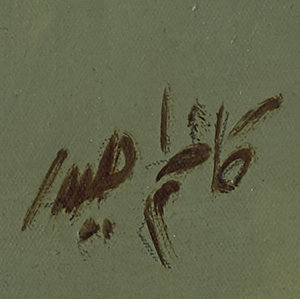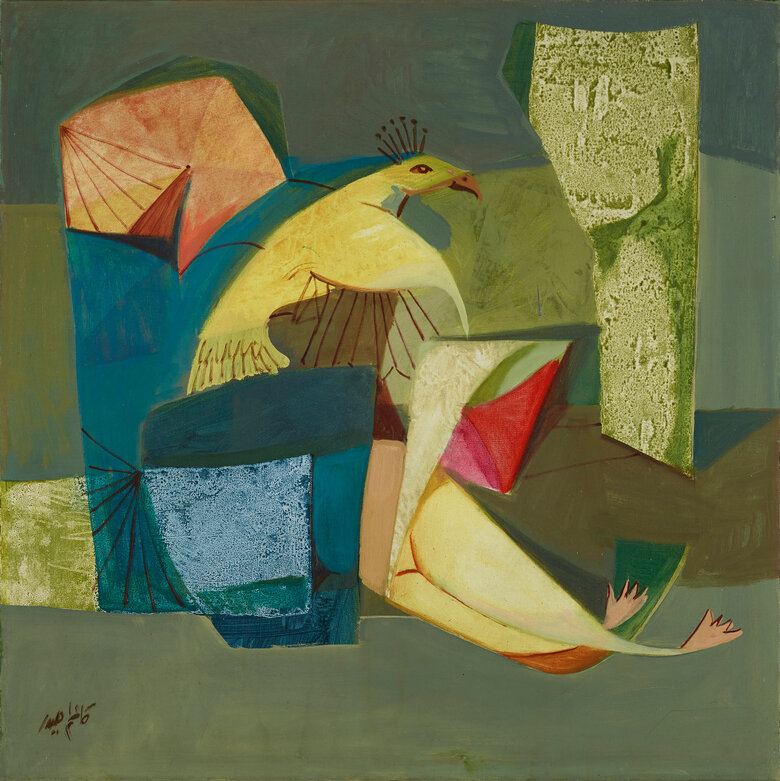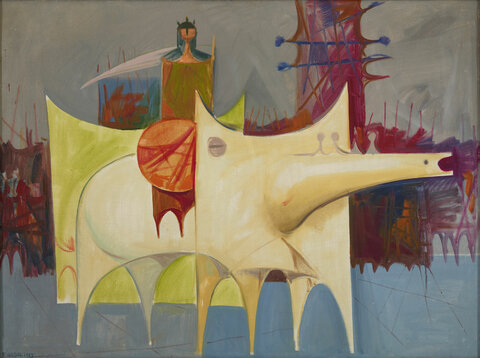Written by Liam Sibai Born in Baghdad in 1932, Kadhim Haydar was a prominent figure in Iraq’s theatre, literary, and visual art scenes. He pursued a degree in literature from the Higher...


KADHIM HAYDAR, Iraq (1932 - 1985)
Bio
Written by Liam Sibai
Born in Baghdad in 1932, Kadhim Haydar was a prominent figure in Iraq’s theatre, literary, and visual art scenes. He pursued a degree in literature from the Higher Institute of Teachers in Baghdad while simultaneously attending night classes at the Institute of Fine Arts, graduating from both in 1957. Two years later Haydar went to London to study lithography, painting, and theatre design at the Central College of the Arts, now known as Central St. Martins. By the early 1960s, Haydar had secured a teaching position at the Institute of Fine Arts in Baghdad. He would later become the President of the Union of Arab Artists, as well as the Vice-President of the Society of Iraqi Artists.
The artist’s work exemplifies trends within much of the Iraqi post-colonial artistic discourse of the 1950s and ’60s. Haydar was a member of several artists’ groups, such as The Pioneers and The Baghdad Modern Art Group, which incorporated the painterly techniques and conceptions associated with European modernists into the visual language of their heritage, be it Islamic or Mesopotamian. In doing so, these groups sought to to sever the association frequently made between the West and the modern, establishing a distinctly Iraqi modernity that drew from Arab rather than European sources. Haydar also participated in the Hurufiyya movement, which took Arabic calligraphy as the starting point for abstract composition. Although his work during this time was steeped in Islamic aesthetic conventions, it also took on contemporary social subjects, as can be seen in He Told Us How It Happened (1957). Using his preferred medium of oil on canvas, the artist portrays a mustached, broad-shouldered, muscular laborer sitting on the floor, his elbow resting on his knee; this ordinary worker is presented heroically, as a storyteller and maker of history. This and similar paintings were produced in a period during which workers protested the increasing cost of living in Baghdad.
Following the 1963 Ba’ath takeover of the Iraqi government, Haydar began to incorporate scenes from Iraqi history into his work, particularly the battle of Karbala (61 AH/680 CE) in which Hussayn ibn ‘Ali was killed. The artist created several variations on this theme in paintings like An Impenetrable Shield (1965) or Martyr’s Epic (1965), in which his subjects’ bodies are distorted with an obscure morbidity that recalls Francis Bacon. Rather than attempting to recreate history, Haydar drew inspiration for these paintings from the annual events of ‘Ashura, when Shi’a Muslims commemorate the battle with mourning rituals, fasting, and reenactments. Such works function in a similar logic to that of the Hussayniyat, a form of poetry that depicts the events of Karbala as something occurring in the present to encourage the audience’s fervent, immediate identification with the story. The artist also took inspiration from a series of poems he wrote himself; while these were in the mournful spirit of the Hussayniyat, they were articulated in free verse, again making a contemporary intervention in patrimonial content. Haydar’s choice of subject matter is also noteworthy given its historical context. In these paintings, he enshrines a moment in ancient Iraqi history that is primarily important to Shi’a Muslims, which, though the majority in Iraq, had begun to be marginalized by the Ba’athist regime.
Stylistically, Haydar tended to portray his subjects rather formulaically in ways that recall Mesopotamian seals, with groups of figures in close proximity converging into masses. His later work places a softer lens on the Islamic and animal motifs he explored as a young artist, as can be seen in Language of The Birds (c. 1980); in this work, the bird is surrounded by gentle floral shades that endow the painting with weightlessness. The title of the piece references the Surat Al-Naml in the Qur’an, in which Solomon mentions the existence of a language only the birds know as a testimony to God’s grace.
Kadhim Haydar was diagnosed with leukemia in 1983, and treating the disease bankrupted the artist. Following this devastating diagnosis and his subsequent financial difficulties, he produced several oil paintings about his struggle with his own mortality. He hoped that sales of these paintings would cover the remainder of his medical expenses, and showed them in what would ultimately be his final exhibition. The show was held at the Iraqi Cultural Centre in London and brought together many of Iraq’s cultural and intellectual figures. Kadhim Haydar passed away a few months after the event in 1985.
Sources
Lenssen, Anneka, Sarah A. Rogers, and Nada M. Shabout. Modern Art in the Arab World: Primary Documents. New York: The Museum of Modern Art, 2018.
“Whitechapel: Imperfect Chronology.” Barjeel Art Foundation, April 12, 2017. https://www.barjeelartfoundation.org/exhibitions/whitechapel-imperfect-chronology/.
Jabrā Jabrā Ibrāhīm. The Grass Roots of Iraqi Art. St. Helier, Jersey, C.I.: Wasit Graphic and Publishing Limited, 1983.
Youssef, Farouk. “Kadhem Hayder Portrait of An Artist.” Gilgamesh, 1986.
Al Bahlooly, Saleem. “The Persistance of the Image Dhakira Hurra in Dia Azzawi's Drawings of the Tel Al-Zaatar Massacre.” Art Margins, 2013.
Hamzah, Jabbar Khammat. “The Metafictional in the Iraqi Art Painting Products.” EUROPEAN ACADEMIC RESEARCH, November 2017.
“Il Nous a Dit Comment Cela S'est Passé (He Told Us How It Happened)”. Barjeel Art Foundation. July 04, 2018. Accessed July 19, 2019. https://www.barjeelartfoundation.org/collection/kadhim-Haydar-il-nous-a-dit-comment-cela-sest-passe/.
"Kadhim Hayder." Barjeel Art Foundation. Accessed July 18, 2019. https://www.barjeelartfoundation.org/artist/iraq/kadhim-hayder/.
Kadhim Haydar. Accessed July 19, 2019. https://artiana.com/Artist/Kad... Haydar." Kadhim Haydar. Accessed July 18, 2019. http://www.encyclopedia.mathaf.org.qa/en/bios/Pages/Kadhim-Haydar.aspx.
"Selected Exhibitions." Kadhim HAIDER | Ibrahimi Collection. Accessed July 18, 2019. http://ibrahimicollection.com/node/84.
"The Sea Suspended: Arab Modernism from the Barjeel CollectionTehran Museum of Contemporary Art – TMOCA." My Art Guides. Accessed July 24, 2019. http://myartguides.com/exhibitions/the-sea-suspended-arab-modernism-from-the-barjeel-collection/.
“ دراسات في الفن العراقي المعاصر جماعة الرواد" . عبد الرحيم , العزاوي. الأدب,١٩٦٦
CV
Selected Solo Exhibitions
1984
The Iraqi Cultural Centre, London, UK
1973
Gallery 3, Baghdad, Iraq
1956
Baghdad, Iraq
1956
Baghdad, Iraq
1954
Higher Institute of Teachers, Baghdad, Iraq
1953
Higher Institute of Teachers, Baghdad, Iraq
1949
Al-Markaziyya Secondary School, Baghdad, Iraq
Selected Group Exhibitions
2024
Arab Presences: Modern Art And Decolonisation: Paris 1908-1988, Musée d'Art Moderne de Paris, Paris, France
Three Tired Tigers, Jameel Arts Centre, Al Kabisi, Dubai, United Arab Emirates
2022
Memory Sews Together Events That Hadn’t Previously Met, Sharjah Art Museum, Sharjah, United Arab Emirates
2020
Modern Masters, Meem Gallery, Dubai, United Arab Emirates
2018
A Century in Flux, Barjeel Art Foundation at the Sharjah Art Museum, Sharjah, United Arab Emirates
2017
Chefs-D’oeuvre De L’art Moderne Et Contemporain Arabe, Institute Du Monde Arabe, Paris
Modern Art from the Middle East, Barjeel Art Foundation at Yale University Gallery, New Haven, US
Mathaf Collection, Summary, Part 2, Mathaf: Arab Museum of Modern Art, Doha, Qatar
2016
A Short Century, Barjeel Art Foundation at the Sharjah Musuem, Sharjah, UAE
The Sea Suspended: Arab Modernism from the Barjeel Collection, Tehran Museum of Contemporary Art, Tehran, Iran
2015
Imperfect Chronology, White Chapel Gallery, London, UK
A Century of Revolutionary Arab Art, London, UK
2014
Sky Over The East, Barjeel Art Foundation at the Emirates Palace, Abu Dhabi, UAE
2013
Re: Orient, Barjeel Art Foundation, Sharjah, United Arab Emirates
1981
Peinture Irakienne Contemporaine, Iraqi Cultural Centre, Paris, France
1978
International Art for Palestine, Arab University, Beirut, Lebanon
1977
Iraqi Cultural Week, Kuwait, Bahrain, Qatar
Iraqi Contemporary Art, Iraqi Cultural Centre, London, United Kingdom
1976
Artists Against Racism, International Artists Association, National Museum of Modern Art, Baghdad, Iraq
Second Arab Art Biennial, Rabat, Morocco
Art Irakien Contemporain, Musée de L’Art Moderne de la ville de Paris, Paris, France
1974
Sixteenth Annual Exhibition of the Society of Iraqi Artists, Baghdad, Iraq
First Arab Art Biennial, Baghdad, Iraq
1973
Group Exhibition at Gallery 3, Baghdad, Iraq
1971
Contemporary Iraqi Art, Mirbad Poetry Festival, Basra, Iraq
The Academicians, National Museum of Modern Art, Baghdad, Iraq
1970
Group Exhibition at National Museum of Modern Art, Baghdad, Iraq
1968
Group Exhibition Museum of Modern Art, Baghdad, Iraq
1967
Group Exhibition with Valentinos Charalambous at the National Museum of Modern Art, Baghdad, Iraq
Az-Zawiya Group, National Museum of Modern Art, Baghdad, Iraq
1966
Carreras Cravan "A" Arab Art Exhibition, Cairo, Egypt; Manama, Bahrain; Kuwait; Baghdad, Iraq; Amman, Jordan; Damascus, Syria; Beirut, Lebanon; London, UK; Paris, France; Rome, Italy
1965
Contemporary Iraqi Art, Sursock Museum, Beirut, Lebanon
Contemporary Iraqi Art, Rome, Italy
Contemporary Iraqi Art, Budapest, Hungary
Contemporary Iraqi Art, Vienna, Italy
Contemporary Iraqi Art, Madrid, Spain
Contemporary Iraqi Art, London, United Kingdom
Eight Annual Exhibition of the Society of Iraqi Artists, National Museum of Modern Art, Baghdad, Iraq
Group Exhibition at Gallery One, Beirut, Lebanon
1964
Seventh Annual Exhibition of the Society of Iraqi Artists, National Museum of Modern Art, Baghdad, Iraq
1958
Exhibition of the Rejected, Union of Iraqi Women, Baghdad, Iraq
1957
Baghdad Exhibition, Nadi Mansour, Baghdad, Iraq
Pioneers, Institute of Fine Arts, Baghdad, Iraq
1956
Pioneers, Institute of Fine Arts, Baghdad, Iraq
Pioneers, Nadi Mansur, Baghdad, Iraq
Young Artists of the Near East, traveling exhibition in the US
Collections
Ramzi and Saeda Dalloul Art Foundation, Beirut, Lebanon
Ibrahimi Collection, Amman, Jordan
Barjeel Art Foundation, Sharjah, UAE
MATHAF: Arab Museum of Modern Art, Doha, Qatar
National Museum of Modern Art, Baghdad, Iraq
Institut Du Monde Arabe, Paris, France
Documents
The Metafictional in the Iraqi art painting products
Jabbar Khammat Hamzah
European Academic Research, English, 2017
The Persistance of the Image Dhakira Hurra in Dia Azzawi's Drawings of the Tel Al-Zaatar Massacre
Saleem Al-Bahloly
Art Margins, English, 2013
الايهام في اللوحة التشكيلية الاليات والوسائط في أعمال الفنان كاظم حيدر
د. بلاسم محمد/شيماء وهيب
Arabic
At the Exhibition of the Pioneers: some thoughts on the work of Ismail Al-Sheikhly, Kadhim Haidar, Qahtan al-Madfai, Nuri Al-Rawi and Suzanne Al-Sheikhly
Sami Mehdi
Baghdad No 19/MAIA Archives, Arabic, 1965
1966-al-adab-al-ruad-vol-14-no-4-Abdulrahim Al Azzawi.pdf
عبدالرحيم العزاوي
Al Adab/MAIA Archies, Arabic, 1966
Kadhim Hayder at Al-Wasiti Gallery
MAIA Archives, Arabic/English, 1964
Kadhim Haidar: Sirat al-Fanaan...Sirat al-Louha (Kadhim Haidar: Life of the Artist...Life of the Canvas)
Dia Azzawi
Nsus/MAIA Archives, Arabic, 1994
Kadhem Hayder Portrait of An Artist
Farouq Yousif
Gilgamesh-Ajournal of Modern Iraqi Art, English, 1986
Press
إستذكار التشكيلي العراقي كاظم حيدر
علي إبراهـيم الدليمي
الزمن, Arabic, 2017
استذكار مميز للتشكيلي العراقي الراحل كاظم حيدر
عبد الجبار العتابي
ايلاف, Arabic, 2019
Kadhim Hayder – Fatigued Ten Horses Converse with Nothing
JOHNJOSEPHLYONS, English, 2015
مجلس المخزومي يستذكر الفنان التشكيلي كاظم حيدر
الدكتور رافد علاء الخزاعي
Independent Press Agency, Arabic, 2013
الفنان كاظم حيدر أداة إبداعية 00 في التقنية واللون والتصميم
Telskof, Arabic, 2010
الفنان التشكيلي كاظم حيدر/وأرجوانية ملحمة ألطف في لوحات الشهيد الإمام الحسين
عبد الجبار نوري
صحيفة المثقف, Arabic
كاظم حيدر والابتكار في تصميم المناظر والأزياء المسرحية العراق
محسن النصار
Arab Theatre Institute, Arabic, 2017
كاظم حيدر والتحديث في معمار العرض المسرحي
المدى, Arabic, 2017
الفنان كاظم حيدر: أخاف المجهول والأسلوب هو أنا
النقد العراقي, Arabic, 2017
بيت المدى يستذكر الفنان الراحل كاظم حيدر ومختصون يعدوه "متفرداً" بالفن العراقي
لمدى برس
المدى Press, Arabic, 2017
كاظم حيدر:التجريب واللّعب والموت
مي مظفر
المدى, Arabic, 2017
كاظم حيدر بلوحة واحدة غيّر مسار الفن في العراق
Farouk Youssef
العرب, Arabic, 2017
انفعالية التجسيد التشكيلي عند الفنان كاظم حيدر
د.ماضـي حســن نعمــة
الصدى, Arabic, 2017
A more important piece than anticipated': Kadhim Hayder's 'Divine Horses' among Middle East art sale at Bonhams
Melissa Gronlund
thenational.ae, English, 2020
Archives tell us different stories about how things were: Inside the journey to document Modern Arab art
Melissa Gronlund
thenational.ae, English, 2020
جسد كاظم حيدر واقعة الطف في مجلس المخزومي الثقافي
الدكتور رافد علاء الخزاعي
جمعرت ذي قار, Arabic, 2013
KADHIM HAYDAR Artwork
Become a Member
Join us in our endless discovery of modern and contemporary Arab art
Become a Member
Get updates from DAF
Follow Artists
Save your favourite Artworks
Share your perspectives on Artworks
Be part of our community
It's Free!
We value your privacy
TermsCookiesPrivacy Policies
Become a Member
Get updates from DAF
Follow Artists
Save your favourite Artworks
Share your perspectives on Artworks
Be part of our community
It's Free!
We value your privacy
TermsCookiesPrivacy Policies
Become a Member
Get updates from DAF
Follow Artists
Save your favourite Artworks
Share your perspectives on Artworks
Be part of our community
It's Free!
We value your privacy
TermsCookiesPrivacy Policies
Welcome to the Dalloul Art Foundation
Thank you for joining our community
If you have entered your email to become a member of the Dalloul Art Foundation, please click the button below to confirm your email and agree to our Terms, Cookie & Privacy policies.
We value your privacy, see how
Become a Member
Get updates from DAF
Follow Artists
Save your favourite Artworks
Share your perspectives on Artworks
Be part of our community
It's Free!
We value your privacy
TermsCookiesPrivacy Policies






